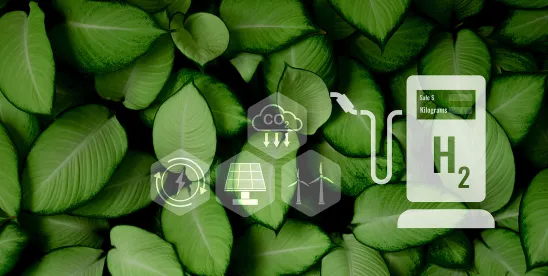The U.S. Department of Energy's (DOE) Regional Clean Hydrogen Hubs (H2Hubs) program, a cornerstone of the previous administration’s climate and energy strategy, has encountered significant changes under the new administration. Once a flagship initiative to build a nationwide clean hydrogen economy, the H2Hubs program is now at a political and operational crossroads, with shifting federal energy priorities reshaping its trajectory.
Funding Changes for Several Hubs
One of the most immediate and impactful changes since January involves a proposed rollback of funding for more than half of the originally approved hydrogen hubs. The DOE confirmed it was considering reducing or eliminating funding for four of the seven selected hubs in March 2025 — those based in California, the Mid-Atlantic, the Pacific Northwest and the Midwest — that represent nearly 60% of the $7 billion in federal support initially committed to the program. Conversely, funding for hubs located in Appalachia, the Gulf Coast and the Upper Midwest appear to have maintained support of the new administration funding.
The DOE aims to reach decisions on funding by the end of the summer. This potential reallocation of funding aligns closely with the new administration’s broader policy emphasis on regions with strong ties to traditional energy industries and that have more closely aligned federal and state energy priorities.
Accelerated Tax Credit Timelines Threaten Project Viability
Another critical shift came through tax legislation recently enacted as part of the One Big Beautiful Bill Act (OBBBA), which amended the eligibility timelines for the 45V Clean Hydrogen Production Tax Credit. Under the prior rules, hydrogen production facilities had until January 1, 2033, to begin construction to qualify for the credit. The OBBBA moved this deadline to January 1, 2028, despite substantial industry pressure to extend the deadline to at least January 1, 2030.
While the updated January 1, 2028, deadline is a one-year extension from the cutoff initially proposed by the House, the window to complete permitting, design finalization and financing has still been reduced by five years. This has raised concerns from many stakeholders, specifically those involved in large-scale, green hydrogen projects that rely on renewable energy and new infrastructure. The abbreviated timeline has:
- Disrupted long-term planning by making it more challenging for developers to align financing and procurement schedules with compressed construction start dates.
- Shifted advantages to fossil-fuel-based “blue hydrogen” projects that are faster to deploy and backed by existing energy infrastructure. The OBBBA also retains the 45Q tax credits established in the Inflation Reduction Act for carbon sequestration that will provide support for blue hydrogen projects.
- Created legal and administrative uncertainty due to the absence of transitional provisions for projects already under development or negotiation.
As a result, industry groups have warned that investment in the U.S. hydrogen sector, and particularly in green hydrogen, may be diverted to international markets with more stable incentives, notably in Europe and Asia. The European Union (EU) is particularly well suited to help fill the gap via the renewable hydrogen energy strategy launched in 2022, including establishment of the European Hydrogen Bank to fund development of an EU hydrogen market to compete with the U.S. H2Hub program.
DOE Oversight and Risk Management Shortcomings Identified
The DOE’s Office of Inspector General issued a critical report on the management of the H2Hubs program in June 2025. The report revealed that, despite the program’s rapid expansion and growing complexity, the DOE had failed to implement a comprehensive program-level risk assessment. Additionally, there was no formal workforce plan in place, despite a growing team that by mid-2024 included more than 250 federal staff and 165 contractors.
With the program’s federal cost share increasing and total project costs increasing from $14 billion to nearly $50 billion, changing the government-to-recipient cost share from 50/50 to 14/86, these governance and staffing challenges pose a major risk to the program’s execution.
Shift in Federal Energy Policy Priorities
The evolution of the H2Hubs program in 2025 is not occurring in isolation, but rather as part of a broader transformation in U.S. energy policy under the current administration. With increased focus on fossil fuel development and reduction of regulatory constraints, federal agencies are recalibrating their priorities away from the previous administration’s decarbonization initiatives.
At the DOE, this shift has been integrated into the H2Hub program in several ways: a focus on hydrogen hubs in states with established traditional energy sectors; prioritization of “blue hydrogen” pathways supported by natural gas infrastructure; and less focus on environmental justice, community benefits and long-term climate goals that were embedded in the original H2Hubs framework.
Summary Table of Key Changes
| Issue | Pre-2025 Status | Post-2025 Status |
| Hub Funding | $7B committed across 7 regional hubs | Possible reduction to $3B committed to 3 hubs |
| 45V Tax Credit Deadline | Construction starts by Jan. 1, 2033 | Deadline moved up to Jan. 1, 2028 |
| Risk and Workforce Management | Limited formal oversight amid growing staff and complexity | Formal risk plan due in Dec. 2025 and workforce plan due in Sept 2025 |
| Energy Policy Focus | Focus on clean energy, decarbonization community equity | Focus shifted toward fossil fuel sectors and deregulation |
Looking Ahead
The future of the H2Hubs program remains uncertain as the evolving federal energy priorities continue to reshape clean hydrogen policy. While some hubs may still receive support — particularly those aligned with fossil-fuel infrastructure — the program’s original goals of decarbonization, economic equity and national hydrogen sector leadership face challenges. Whether these shifts will be tempered in response to market dynamics or international competition remains to be seen, but the window for stable and scalable hydrogen deployment in the U.S. appears to be narrowing.




 />i
/>i

